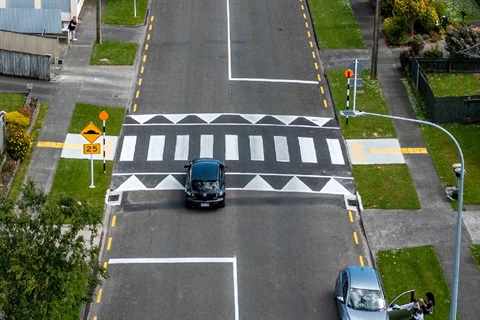Get a speed hump or raised pedestrian crossing on my street

Learn more about the process for getting a speed hump or raised crossing on your street.
We use speed humps and raised pedestrian crossings to encourage motorists to drive slowly and carefully.
There are many other traffic calming measures that are considered before speed humps, as there are strict guidelines for installing speed humps which are set by local and national best practice guidelines.
Someone is driving dangerously on my street
If you see anyone driving dangerously, please call NZ Police on 111 for emergencies, or call *555 free from a mobile phone. Please note that *555 will not work from a landline, only from a mobile phone.
A speed hump has a sharp gradient, which is useful for slowing vehicles down. Speed humps can be costly and affect everyone. They can be useful in slow-speed areas like parking lots or shared areas with non-motorized vehicles, but they should not be the first tool used to manage speed on urban streets. Surveys show that they tend to increase speeds between speed humps and noise levels when drivers slam on the brakes and then take off after they clear the hump. Additionally, they can cause environmental pollution, stormwater flow problems, and debris build-up.
Places where installing speedbumps are not allowed:
- National roads
- Regional roads
- Arterial roads
- Primary Collector roads
Places where speedbumps may be considered:
- Secondary collector roads
- Access roads
A raised pedestrian crossing has a level surface that is easier for larger vehicles to negotiate and for pedestrians to cross at. They generally have a flat surface and sit flush with the kerbs or roadside drains. They are mainly used near busy intersections or main crossing locations, such as in the city centre or at school entrances, but they can be used in residential areas with plenty of pedestrian activity.
When determining the best type of traffic calming solution, we consider many factors alongside concerns raised by residents.
What happens after you contact us
After you contact us, there are several ways we may proceed.
- We might decide to initiate a safety review to help us determine if a traffic calming solution is required and, if so, which is the best type. This can take several months.
- Evidence such as traffic and speed counts may determine there isn’t a need for traffic calming measures in that area or street at all.
- We may decide to proceed with a speed bump or that another solution is more appropriate in the situation.
- If we do decide a speed hump is the best solution, it often takes more than 12 months to work through the budgeting, design and construction phases.
Need help?
If you think you need speed humps or would like someone to look at traffic calming measures on your street, you can phone our Contact Centre on 06 356 8199 or email info@pncc.govt.nz.